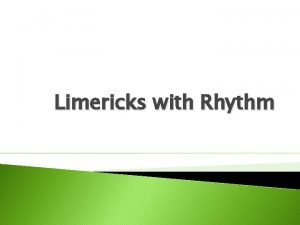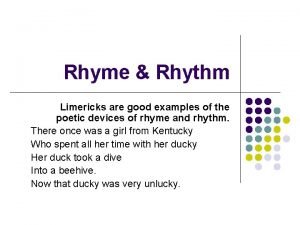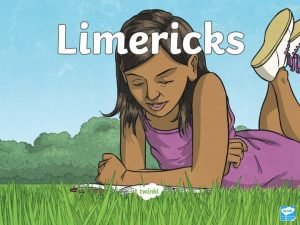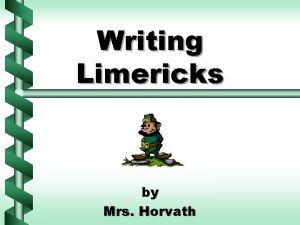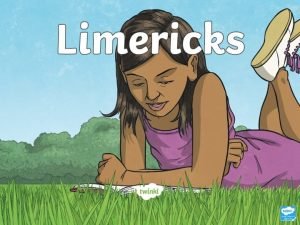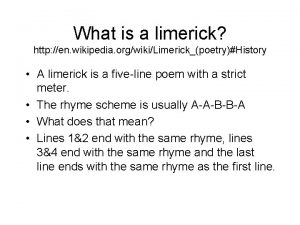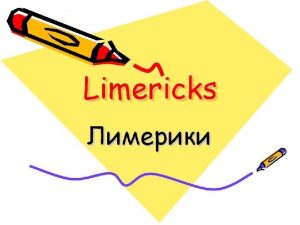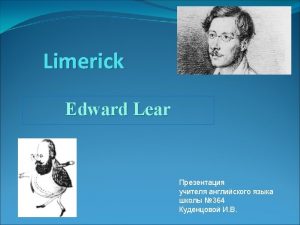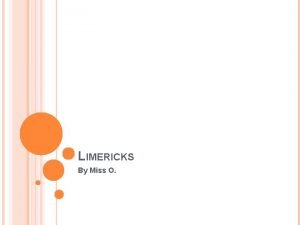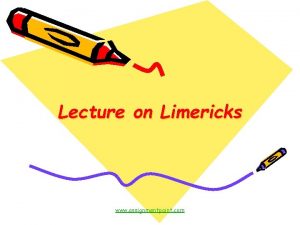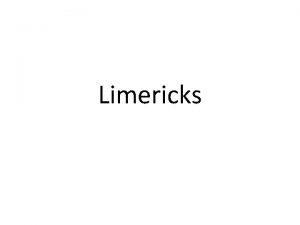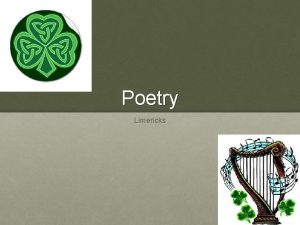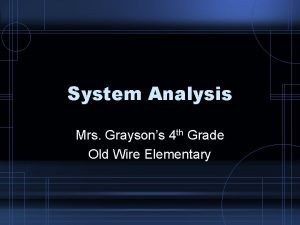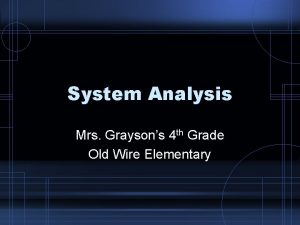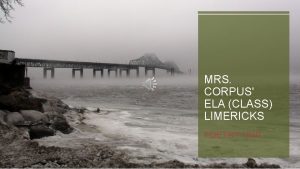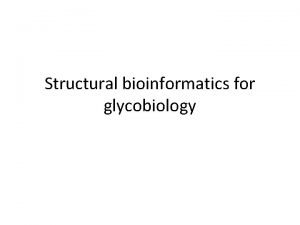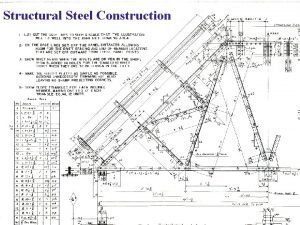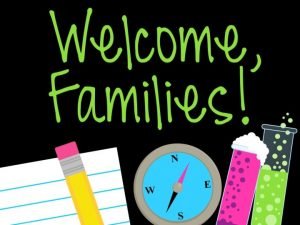Structural Elements of Limericks Mrs Graysons 4 th















- Slides: 15

Structural Elements of Limericks Mrs. Grayson’s 4 th Grade Old Wire Elementary Mrs. Goff, Literacy Facilitator

Unit Preparation Prior to beginning Unit 3, Mrs. Grayson did the following: 1. Identified the standards to be taught- (she looked at the unit 3 pacing guide) 2. She asked herself– “What will my students know and be able to do better at the end of this unit? ” • 3. She gathered and studied the resources in order to prepare the daily lessons.

Plan Daily Lessons: Once Mrs. Grayson had the big picture for the unit, she began planning daily lessons. The standard she based this lesson’s goal on is: RI. 4. 5 Explain the major differences between poems, drama, and prose, and refer to the structural elements of poems (e. g. , verse, rhythm, meter) and drama (e. g. , casts of characters, settings, descriptions, dialogue, stage directions) when writing or speaking about a text. The resources she selected for the lesson are: • Copies of limericks from the internet • Interactive Notebook

GANAG is a daily lesson structure that allows teachers to plan for student use of research based instructional strategies. G= goal A= access prior knowledge N= new information A= application G= generalize the goal

GANAG provides students the opportunity to actively use the nine high-yield strategies: (2) Identifying Similarities and Differences (3) Summarizing and Note Taking (4) Reinforcing Effort and Providing Recognition (7) Cooperative Learning (8) Setting Objectives and Providing Feedback (9) Generating and Testing Hypotheses (5) Homework and Practice (6) Nonlinguistic Representations (10) Cues, Questions and Advance Organizers

Goal: I can tell the structural elements of a limerick. Students wrote the goal in their notebooks and scored both their understanding and effort. (4) Reinforcing Effort and Providing Recognition (8) Setting Objectives and Providing Feedback

Access Prior Knowledge Mrs. Grayson displayed pictures from previous lessons on her Smart. Board. Students talked about what they noticed with their partner. (6) Nonlinguistic Representations (7) Cooperative Learning

New Information Students took notes in their notebook, listing the parts of a limerick. (3) Summarizing and Note Taking

Mrs. Goff displayed limericks from the internet. The students identified the limerick as a system. They used the notes in their notebooks to identify the parts of the limericks. Systems Analysis: viewing something as a system. 1. I identify something as a system. 2. I state all the parts of the system and how they work. They discovered the “rhythm” of a limerick by reading them aloud.

Application Systems Analysis: viewing something as a system. 1. I identify something as a system. 2. I state all the parts of the system and how they work. 3. I change one part of the system to see what would happen. The students worked in groups. Each group was given a limerick and asked to make a change. (10) Cues, Questions and Advance Organizers 4. Make a conclusion about how the one change made the system change. 5. Repeat the process.

The group shared their changes, and the conclusions they made.

Revisit the Goal The students revisited the goal and scored their understanding and effort at the end of the lesson.


The next day. . .

Marzano, R. J. , Pickering, D. J. , & Pollock, J. E. (2001). Classroom instruction that works: Research-based strategies for increasing student achievement. Alexandria, VA: Association for Supervision and Curriculum Development. Pollock, J. E. (2007). Improving student learning one teacher at a time. Alexandria, VA: Association for Supervision and Curriculum Development. Pollock, J. E. , & Ford, Sharon M. (2009). Improving student learning one principal at a time. Alexandria, VA: Association for Supervision and Curriculum Development. Pollock, J. E. , Ford, Sharon M. , & Black, Margaret M. (2012). Minding the Achievement Gap. Alexandria, VA: Association for Supervision and Curriculum Development.
 Mrs. darling was ___________ of mrs. s.
Mrs. darling was ___________ of mrs. s. They are mrs garcia and mrs castro
They are mrs garcia and mrs castro They are mrs garcia and mrs castro
They are mrs garcia and mrs castro Limerick syllables
Limerick syllables Rhyme and rhythm
Rhyme and rhythm Lighthearted poems
Lighthearted poems Limerick sample
Limerick sample Limerick poem
Limerick poem Limericks origin
Limericks origin Characteristics of limerick poems
Characteristics of limerick poems What is a limerik
What is a limerik Limerick poem creator
Limerick poem creator Haiku and limerick examples
Haiku and limerick examples Limerick example
Limerick example Triplet rhyme
Triplet rhyme Struts and frame structures
Struts and frame structures



